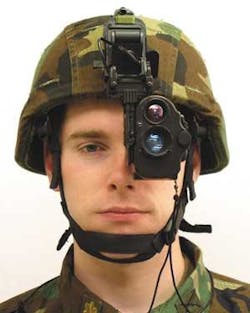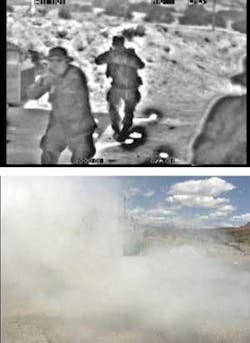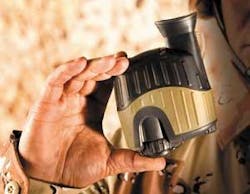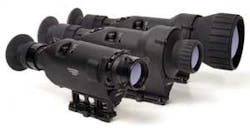By John McHale
Designers of infrared technology for military applications are all in agreement-business is not only good, but continued growth and support for new designs and capability are expected. Success on night battlefields has made the U.S. soldier hungry for even more products and new capabilities.
Business has been outstanding for BAE System’s infrared products, says Dave Smialek, business development manager for BAE Systems (IR Imaging Systems) in Billerica, Mass. Recent wins include the Thermal Weapon Sight for the U.S. Army’s Stryker vehicle, Smialek adds.
The BAE Systems Thermal Weapon Sight (TWS) is an advanced next-generation family of light, medium, and heavy sights developed in partnership with Program Executive Office Soldier and BAE Systems in Billerica, Mass. The TWS enables weapon gunners to see deep into the battlefield, increasing their surveillance and target-acquisition range.
The TWS complements current and future infantry armament providing the warfighter with the ability to reach out and overmatch the enemy in all battlefield conditions and obscurants day and night, BAE Systems officials say.
All three variants of the TWS are designed around a highly modular and common MicroIR microbolometer sensor architecture that provides high sensitivity in a small, lightweight package. This same modular MicroIR technology has been well-proven by BAE Systems in firefighting, first responder, and homeland security applications. In addition, the three TWS variants are designed around common and modular assemblies that reduce logistics and depot level requirements.
“Our core technology is uncooled infrared imaging,” Smialek says. Uncooled technology does not require the refrigeration device of a cooled infrared product, thereby reducing cost of ownership through less maintenance and reducing the burden on the warfighter by reducing weight, he adds.
The TWS provides the warfighter with high performance in a small package size (light: less than 1.8 pounds; medium: less than 2.8 pounds; and heavy: less than 3.9 pounds) offering dual field of view (FOV) via E-Z00M capabilities. The sights feature electronically programmable reticles and have alpha/numeric system information overlayed on the eyepiece display and analog video output.
Officials at ITT Industries Night Vision in Roanoke, Va., continue to provide their Enhanced Night Vision Goggles (ENVG) to the U.S. military.
The U.S. Army Research, Development and Engineering Command Acquisition Center, Unique Missions Division awarded ITT 100 percent of the ENVG contract with a potential total value of $560 million over five years. ITT continues to work with the customer on refining the system.
The current test phase is likely to last through April 2006, ITT officials say. Twelve systems were delivered to the Army in early November 2005 for testing at Ft. Benning. Fifty-three systems were due to the Army last month with the Army expecting to field them in 2006.
The ENVG optically combines an image-intensification (I2) image and next-generation infrared (IR) image, providing improved mobility and situational awareness through clear target identification (I2) and improved target detection (IR).
The ENVG helps warfighters do their jobs more safely and effectively, says Larry Curfiss, ITT’s vice president and director of business development.
ITT’s Night Vision technology is impressing European militaries as well, Curfiss says.
While I2 and IR technologies have allowed the U.S. military and its allies to own the night for years, both technologies have strengths and limitations. The ENVG combines the strengths of both technologies into one unit, allowing soldiers to complete their missions more effectively, even when confronted by low-light conditions or obscurants such as smoke and fog.
For testing purposes, the initial units will be used by Program Executive Office Soldier, the organization tasked with developing, producing, fielding, and sustaining everything that the soldier wears, carries, and operates, ITT officials say.
FLIR Systems in Wilsonville, Ore., announced the launch of a new product line to address the needs of tactical ground forces. FLIR’s new TacFLIR product line will provide capability and situational awareness to aid in reconnaissance, surveillance, and target-acquisition (RSTA), and fire-control missions.
The TacFLIR is designed for use on manned and unmanned platforms and incorporates FLIR Systems’ industry leading thermal imaging technology. Robust environmental hardening combined with high-performance sensors make the TacFLIR an ideal solution for demanding ground mobility applications, FLIR officials say. Integrated with optional multisensor payloads, the TacFLIR is uniformly capable during the day or in total darkness.
“TacFLIR capitalizes on the best of FLIR’s recent development efforts,” says Rick Mannello, vice president of Land Systems. Advanced capabilities developed during the execution of several major U.S. military programs, coupled with experience from having fielded over 250 similar systems for extreme military environments aided the design of this product.
The TacFLIR III multisensor system delivers crisp, stable imagery regardless of vehicle movement or vibration. With 450 mm of continuous, high-sensitivity thermal-imaging zoom, the system will see targets at extreme ranges in total darkness, through smoke, fog, and most battlefield obscurants. When coupled with a GPS/IMU/INS the eye-safe laser rangefinder will deliver precision geo-targeting, FLIR officials say. The daylight/lowlight camera provides additional tactical advantages for daytime missions. In addition, the system can be configured with a laser pointer, which allows operators to pinpoint targets of interest for those using night-vision equipment. A variety of hand- and remote-control options are available.
A thermal-imaging camera from L-3 Communications Infrared Products in Dallas is offering improved image quality for warfighters.
The L-3 next-generation thermal-imaging camera, the X200xp offers advanced overall image quality in a conveniently sized, rugged, and cost-effective package. The 13-ounce X200xp is designed for use in military and law-enforcement applications.
It was just released this year and its predecessor, the X100xp has been fielded in battle in Iraq and Afghanistan, says Michele Peters, marketing communications manager, Infrared Products at L-3 Communications in Dallas. “It is a popular tool among soldiers, government agencies and even local law enforcement,” says Peters. “It is one of the smallest on the market to provide the imagery it does and operates on low power with two AA batteries.”
The Thermal-Eye X200xp offers 50 percent greater stand-off range than the previous generation’s unit and can detect human activity at as far as 1,500 feet, about the length of four football fields, company officials say.
The X200xp also has improved image processing for best-in-class image quality. The unit’s sophisticated image processing provides greater scene detail and improved clarity and sharpness. The technology also offers improved vision in challenging field conditions like dust, smoke, and complete darkness, all while preventing a blooming effect from nearby lights common in image intensification cameras. The 30-hertz, 30-µm detector ensures not only a fast turn-on time, but also real-time video imaging.
“L-3’s Thermal-Eye cameras have proven to be immensely powerful tools for numerous law-enforcement officials,” says Charles A. Stowell, executive director of LETA, who is a retired DEA agent. “The improved clarity, sharpness, and ability to see well not only in total darkness, but also through smoke, dust, and fog, make the X200xp the ideal tool for everything from target detection and fugitive pursuits to search and rescue missions.”
The camera’s petite frame is stored easily in pockets for quick extraction and covert operation in the field and on the run. The unit’s unique rugged design includes an integral rubber eyecup and can survive accidental drops. In addition, the X200xp also can withstand underwater submersion up to nine feet.
L-3 Communications Infrared Products designs, manufactures, and sells a wide range of thermal imaging products and solutions serving the security, fire and rescue, public safety, law enforcement, transportation, industrial, utilities and Homeland Security markets. For more information visit www.thermal-eye.com.
L-3 has been expanding its infrared portfolio as evidenced by its recent purchase of EOTech Inc. of Ann Arbor, Mich. EOTech designs, manufactures and markets electro-optical products and systems.
Cedip Infrared Systems in Croissy-Beaubourg, France, specialists in thermal-IR cameras and systems, announced the launch of PHAROS, a high-resolution multisensor platform specifically designed for short- to medium-range day/night surveillance applications.
PHAROS features a state-of-the-art 384 by 288-pixel uncooled microbolometer thermal imager (nighttime), a CCD camera (daytime), and an optional 2500-meter laser range finder, all integrated on a motorized pan and tilt platform. Weighing 5 kilograms, the compact PHAROS is housed in a robust IP65 enclosure allowing it to operate effectively in all weather conditions, Cedip officials say.
Providing high sensitivity and operating throughout the long-wavelength IR (8 to 14 µm), PHAROS provides high day/night detection capability in all visibility conditions, enabling PHAROS to perform as a surveillance system for early fire detection in industrial production facilities and for detecting intruders in sensitive areas such as nuclear installations, power plants, harbors, airports, and territorial borders.
PHAROS can be easily set up in the field, mast mounted on top of a vehicle, or integrated into a video security network, company officials say. PHAROS can also be operated as a stand-alone system from a remote shock and waterproof command unit with built-in monitor providing full control of the system and display of both video channels.
The infrared military market has been lucrative to Cedip. The company’s business in Europe continues grow at a robust pace, says Jon Chicken, sales manager for Cedip. The company announced its fourth consecutive year of double-digit growth in international sales. In 2004, Cedip achieved revenue growth of more than 12 percent compared to 2003 with export sales (outside of France) accounting for 70 percent of turnover.
For more information on Cedip Infrared Systems visit www.cedipinfrared.com.




